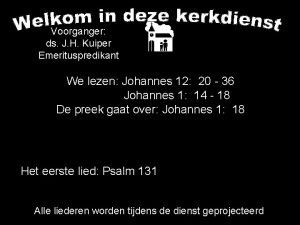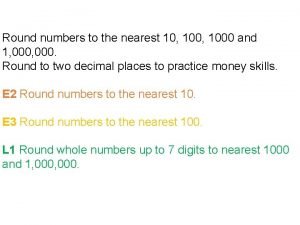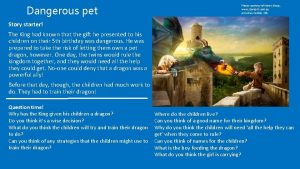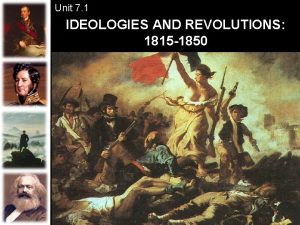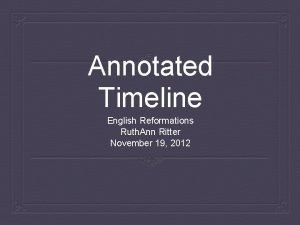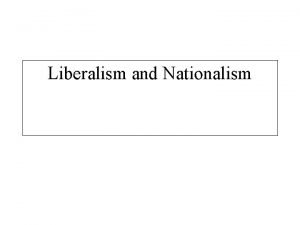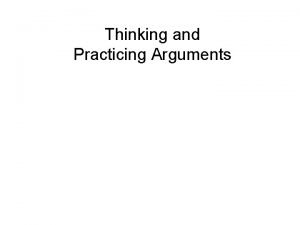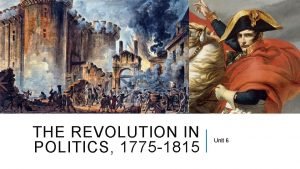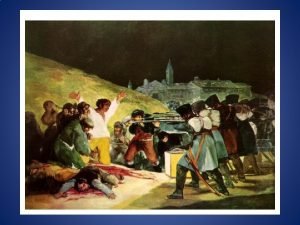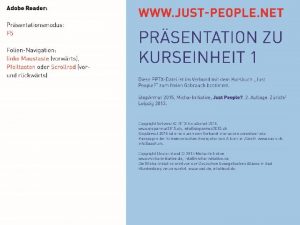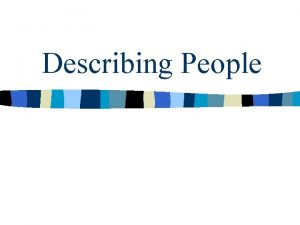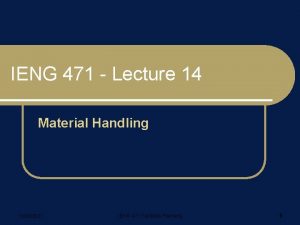IENG 366 Leading Technical People Reading pp 50

























- Slides: 25

IENG 366 Leading Technical People Reading: pp. 50 – 64.

NATURE OF LEADERSHIP “Leadership is the ability to get people to do what they don’t want to do and like it” Harry S. Truman

Some of the leader and manager characteristics according to Warren Bennis described in the following chart: Managers Leaders Administer Innovate Ask how and when Ask what and why Focus on systems Focus on people Do things right Do the right things Maintain Develop Short term perspective Longer term perspective Imitate Originate Are a copy Are original Managers & Leaders are Different

• Planning • Organizing • Staffing • Leading • Controlling Functions of Managers: Kootz (Fayol)

Are Leaders Born or Are Leaders Made? • How does one become Queen or King today? • How did one become a Monarch in Medieval Times? • How did the earliest Kings (or Queens) get selected? • Are there parallels in non-Western cultures? Leadership

Born Leaders? • Physical Qualities: Health, Vitality, Endurance • Personal Attributes: Personal Magnetism, Cooperativeness, Enthusiasm, Ability to Inspire, Persuasiveness, Forcefulness, Tact • Character Attributes: Integrity, Humanism, Self-Discipline, Stability, Industry (hard work) • Intellectual Qualities: Mental Capacity, Ability to Teach, Scientific Approach to Problems Leadership: Traits Peterson & Plowman


Myers-Briggs Type Indicator (MBTI): • • Extroversion vs Introversion: Extroverts focus on the outer world of people and things Introverts focus on the inner world of ideas and impressions Intuition vs Sensing: INtuition focuses on the future, with a view toward patterns and possibilities Sensing focuses on the present and on concrete information gained from the senses Thinking vs Feeling: Thinking bases decisions on logic and on objective analysis of cause and effect Feeling bases decisions on values and on subjective evaluation of personal-centered concerns Judging vs Perceiving: Judging prefers to have things settled – a planned & organized approach to life Perceiving prefers to keep options open – a flexible & spontaneous approach to life Successful Engineering Managers often evaluate as ENTJ Leaders in Research Organizations often evaluate as INTJ Only about 2% of the population falls into either of those two categories! Leadership: Traits

NATURE OF LEADERSHIP “If your actions inspire others to dream more, learn more, do more and become more, you are a leader. ” John Quincy Adams

Can one Learn to be a Leader? The Ohio State Studies: Looked at over a thousand dimensions of leaders, boiled them down to two: • Initiating Structure (IS): A leader high in initiating structure will assign group members to tasks, and expect them to maintain performance standards and meet deadlines. A leader might also be low in initiating structure. • Consideration (C): A leader high in consideration is friendly, approachable to subordinates, helps them with personal problems, and treats them as equals. A leader might also be low in consideration. A leader high in both IS and C (high-high) generally got both better subordinate performance and satisfaction ratings. But, when subordinates were performing routine tasks, the high-high leaders tended to have more turnover, more grievances, more absenteeism and had lower job satisfaction among their workers. And High C leaders tended to get lower performance ratings by their supervisors. Leadership: Behavioral

Can one Learn to be a Leader? The University of Michigan Studies: (1940 s) looked at behaviors related to effective performance – found two grid dimensions: • Employee Oriented: A leader who was employee oriented tended to emphasize interpersonal relationships, took interest in the needs of their subordinates, and accepted differences. • Production Oriented: A leader who was production oriented usually emphasized the technical/task nature of the job and were mainly concerned with accomplishing the groups tasks. They rewarded their workers as a means to achieve those goals. Conclusions showed that employee oriented leaders were strongly favored to obtain higher group productivity and higher group satisfaction. Production oriented leaders were associated with low group productivity and lower group satisfaction. The OSU and U. Mich. studies had enough exceptions to show that situational factors also play a significant part. Leadership: Behavioral

Can one Learn to be a Leader? The Leadership Grid: Put the U. Mich. and OSU studies into a two dimensional grid. Dimensions were: • Concern for People (Employee Oriented / Consideration): Scale ran form 1 to 9, with higher values emphasizing interpersonal relationships subordinates, needs of their subordinates, and tendency to accept subordinates as equals. • Concern for Production (Production Oriented / Initiating Structure): Scale also ran from 1 to 9, with higher numbers emphasizing the tasks to be done, the performance to be attained, and accomplishing the group’s tasks on-time. Result was a 9 x 9 grid showing where the dominant factors in the leader’s thinking were when trying to obtain the desired performance. Five of those regions became named and described. (see next slide) Conclusion was that a 9, 9 style was best for managers, but there was little evidence that using 9, 9 worked best in ALL situations – or that a 9, 9 style was even possible in most circumstances. Leadership: Behavioral Blake & Mouton

Figure 3 -1 The Leadership grid figure. From Leadership Dilemmas—Grid Solutions, by Robert R. Blake and Anne Adams Mc. Canse. Gulf Publishing Company, Houston, TX, copyright 1991 by Scientific Methods Inc. , p. 29; reproduced by permission of the owners.

Leadership is Situational Life Cycle (Maturity) Theory: Put the OSU dimensions into a 2 x 2 matrix. Again, the dimensions were: • Initiating Structure (IS): A leader high in initiating structure will assign group members to tasks, and expect them to maintain performance standards and meet deadlines. A leader might also be low in initiating structure. • Consideration (C): A leader high in consideration is friendly, approachable to subordinates, helps them with personal problems, and treats them as equals. A leader might also be low in consideration. The most effective leadership style progresses with time through all four “quadrants” of the OSU model during the life cycle of the task (as annotated on the next slide). Leadership: Contingency Hersey & Blanchard

Table 3 -2 Ohio State Leadership Styles Life Cycle (Maturity) Theory Leadership: Contingency Hersey & Blanchard

Leadership is Situational Continuum. Theory: Review the OSU dimensions, treating the degree of emphasis as a spectrum between: • Autocratic Leadership: where the leader makes the decision, tells subordinates, and expects them to carry out that decision. • Democratic Leadership: where the leader fully shares the decision-making power with subordinates, with each group member having an equal voice/vote. • Continuum is Zero Sum: The leadership emphasis starts at 100%/0% at one end, progresses through 75%/25%, and 50%/50%, past 25%/75%, and ends at 0%/100% at the far end of the scale. Where the leader chooses to be on the continuum depends on the situation … Leadership: Contingency Tannenbaum & Schmidt

Use of Autocracy by Leader Use of Democracy by Leader

Leadership is Evolutionary Servant Leadership: Practical philosophy of leadership gaining more acceptance over time: • (Future Leader) Serves First … Similar to an apprenticeship or an engineering intern or a six-sigma green belt – usually rotating through a variety of situations – as a way to gain knowledge through experience. • … then Becomes a Leader–in–Service: where the leader expands her / his service to the individuals and the organization – similar to becoming a professional engineer or six-sigma black belt – by taking charge of a group of future leaders and passing on her / his knowledge. • Servant Leadership Emphasizes: collaboration, trust, empathy, and the ethical use of power – rather than top–down power. Leadership: Contingency Greenleaf (and others)

One more viewpoint 14 Types of Executive (Leader) Behaviors: • Eight Leadership Styles for those who were Merely Successful: “ … and could have been more effective were it not for some serious weaknesses”. • Six Leadership Approaches that are Effective: “ … in the right situation”. • Situational Leadership means that the leader must understand the motivations of (or how to motivate) subordinates. … we will talk about motivational theories and models, next time! Leadership: Contingency Cribben



Exploiter Temporizer Glad-Hander “When I bark, they jump. ” “We bend to the strongest pressure. ” Arrogant, insistent, abusive. Demeaning, coercive, vindictive, and domineering. Often quite competent. Rigid, prejudiced, given to snap judgements. Exploits others’ weaknesses. Procrastinating, compromising, and vacillating. Earns contempt. Feels a helpless sense of being put upon. Survival instincts may be superior. May be politically aware. “We sell the sizzle, Ebullient, superficial, effusive, not the steak. ” deceptively friendly, and extroverted. Excellent interpersonal skills. Lacks depth, minimally competent. May be an excellent politician. Survival instincts superior. Talkative, humorous, lacks substance. Exerts constrictive and personal controls. Flogs anyone who is vulnerable. Uses pressure and fear to get things done. Demands subservience. High task orientation. Sees people as minions. Low task orientation, low people concern. Reacts to the strongest immediate pressure. Reactive, not active. Behavior varies with pressures. Sells himself or herself very well. Low or modest task orientation. Unconcerned with people, but excellent in dealing with them. Gets by on “personality. ” Always seeks to impress and to improve his or her position. May use people, but rarely threatens them.

Table 3 -4 Leaders Who Are Effective


Questions & Issues? IENG 366 Engineering Management
 5 letter words with ieng
5 letter words with ieng Objectives of roving frame
Objectives of roving frame Opwekking 366
Opwekking 366 37521 to the nearest 1000
37521 to the nearest 1000 Ps 366
Ps 366 Pobble animal
Pobble animal Each pair of wires is wrapped in metallic foil
Each pair of wires is wrapped in metallic foil 98 366
98 366 Na jednom kraju bakrene cijevi duljine 366 m
Na jednom kraju bakrene cijevi duljine 366 m While reading activities
While reading activities Liberty leading the people, 1830
Liberty leading the people, 1830 Liberty leading the people, 1830
Liberty leading the people, 1830 Liberty leading the people
Liberty leading the people Liberty leading the people 1830
Liberty leading the people 1830 Liberty leading the people
Liberty leading the people Eugene delacroix liberty
Eugene delacroix liberty Reading technical drawings
Reading technical drawings 2 types of people media
2 types of people media Black eyed peas where is the love lyrics
Black eyed peas where is the love lyrics Recovery community
Recovery community Justpeople
Justpeople Describing people reading
Describing people reading Round robin reading vs popcorn reading
Round robin reading vs popcorn reading Difference between silent reading and reading aloud
Difference between silent reading and reading aloud Difference between silent reading and reading aloud
Difference between silent reading and reading aloud Guided reading vs shared reading
Guided reading vs shared reading


